|

 Up
Up 
 Comparing the
Comparing the
1903 and 1904
Aerodromes

(You are here.)



  Need
to Need
to
find your
bearings?
Try
these
navigation aids:
If
this is your first
visit, please stop by:
Something
to share?
Please:



|
|
Available in Française, Español, Português, Deutsch, Россию,
中文,
日本, and others.
|
|
|
 ow
different was the "reconstructed" 1914 version of the Langley
Aerodrome from the original 1903 Aerodrome? The list that Orville
compiled for Smithsonian Secretary Charles Abbot in 1934 cited 26
separate changes that were made to the aircraft before Curtiss flew
it in May and June of 1914. Orville's friend, Griffith Brewer, drew
the front and side views of the Aerodrome as it appeared in 1903 and
1914 to show the changes that had been made to the airframe,
rigging, and overall configuration. ow
different was the "reconstructed" 1914 version of the Langley
Aerodrome from the original 1903 Aerodrome? The list that Orville
compiled for Smithsonian Secretary Charles Abbot in 1934 cited 26
separate changes that were made to the aircraft before Curtiss flew
it in May and June of 1914. Orville's friend, Griffith Brewer, drew
the front and side views of the Aerodrome as it appeared in 1903 and
1914 to show the changes that had been made to the airframe,
rigging, and overall configuration.
We've come up with a different method to show these changes. We've
created detailed 3D digital models of the 1903 and 1914 Aerodrome
and we've rendered these as 3D-PDF files. Using Adobe
Reader (or an Adobe Reader plug-in for your browser) you can
view these aircraft in three dimensions. That is, you can see the
1903 and 1914 Aerodromes from any angle, close in or far away. You
can spin, roll, and turn the aircraft on you computer screen, zoom
in or out, even perform a virtual walk-around. In addition to the 3D
models, we have also provided some traditional 2D art.
We've prepared three different models. The first two are
historically accurate digital representations of the Langley
Aerodrome in 1903 and 1914, and the third is a composite of the two
that shows what parts were added, modified, moved, or discarded when
Curtiss rebuilt the original aircraft.
Important Note: You must have Adobe Reader 9.0
or later to view these models. If you don't already have a
copy of Adobe Reader or want to update your software, you can
download the latest version for free by clicking HERE.
Once you have an up-to-date Reader, simply click on the link to 3D
PDF file and it will load in a secure "protected view." Click
"Enable all features" (at the top right) and the 3D illustration
will appear with all the tools you
need to zoom, pan, slide, and turn the models. PDF readers other
than Adobe, including those that are built in to some browsers, may
not work.
|

Langley’s 1903 Aerodrome or “Aerodrome A” is shown in the top illustration and
its May-June 1914 reincarnation is shown in the middle. At first
glance, these two aircraft look similar to one another. They have
the same wing configuration, tail, airframe, and drive train. It was
this similarity that gave verisimilitude to the Smithsonian claim
that the hop-flights of the 1914 version proved that the 1903
version was airworthy.
However, when
you look past their obvious similarities, these were very different
airplanes. The bottom illustration proves the point. It’s a
composite of both versions of the Aerodrome. The parts of the 1903
Aerodrome that were discarded in 1914 are shown in red, while the
parts that were added or substantially modified in 1914 are shown in
blue |
1903 Langley Aerodrome
|
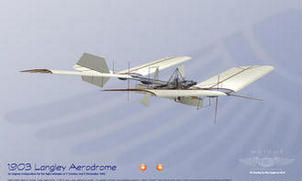
This is the original Aerodrome, as it appeared when Samuel Langley
attempted to fly it on 7 October and 8 December 1903. To see
the aircraft in 3D, click
HERE or on the
illustration. The file is 10.8 Mb and may take some time to load.
Open the 3D-PDF file and click "Enable all features." (The
illustration won't appear when the PDF reader is in the "protected"
mode.) |
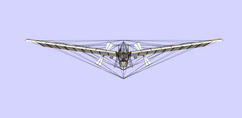
1903 Langley Aerodrome, original configuration, 2D Front View.
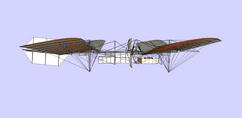
1903 Langley Aerodrome, original configuration, 2D Right Side View.
|
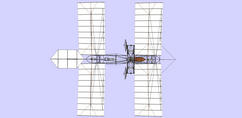
1903 Langley Aerodrome, original configuration, 2D Top View.
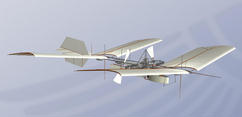
1903 Langley Aerodrome, original configuration, 2D Diagonal View.
|
1914 Langley Aerodrome
|
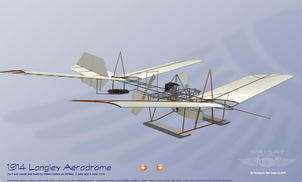
This is the Aerodrome as it appeared when Glenn Curtiss flew it on
28 May, 2 June and 5 June 1914. To see the aircraft in 3D, click
HERE
or on the illustration. The file is 9.8 Mb and may take some time to
load. Open the 3D-PDF file and click "Enable all features."
(The illustration won't appear when the PDF reader is in the
"protected" mode.)
|
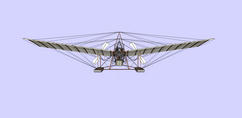
Langley Aerodrome as rebuilt in 1914, 2D Front View.
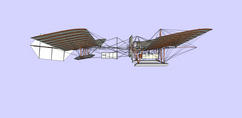
Langley Aerodrome as rebuilt in 1914, 2D Right Side View.
|
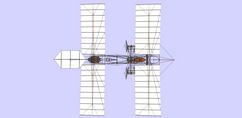
Langley Aerodrome as rebuilt in 1914, 2D Top View.
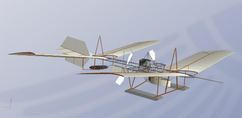
Langley Aerodrome as rebuilt in 1914, 2D Diagonal View.
|
Composite 1903/1914 Langley Aerodrome
|
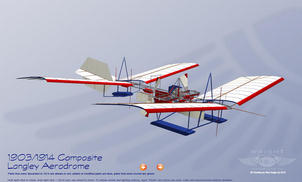
This is a composite of the 1903 and 1914 Aerodromes. The parts shown
in red were eliminated in the 1914 reconstruction; those shown in
blue were added or modified in 1914. Those shown in green were moved
– light green indicates the 1903 position, dark green the 1914
position. To see the aircraft in 3D, click
HERE
or on the illustration. Open the 3D-PDF file and click "Enable
all features." (The illustration won't appear when the PDF reader is
in the "protected" mode.)
|
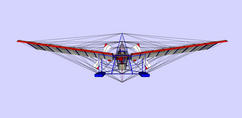
1903/1914 composite of the Langley Aerodrome, 2D Front View.
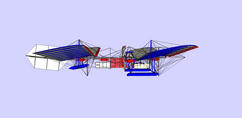
1903/1914 composite of the Langley Aerodrome, 2D Right Side View.
|
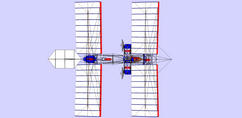
1903/1914 composite of the Langley Aerodrome, 2D Top View.
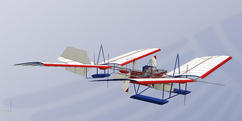
1903/1914 composite of the Langley Aerodrome, 2D Diagonal View.
|
|
Notes on Historical Accuracy
The 3D model of the 1903 Langley Aerodrome is based on
the engineering drawings for "Aerodrome A" that were published in
1911 by the Smithsonian Institution in the "Langley Memoir on
Mechanical Flight" by Samuel P. Langley, edited by Charles Manly, and
"Langley's Aero Engine of 1903" edited by Robert B. Meyer, Jr.
We also traveled to the Smithsonian's Stephen F. Udvar-Hazy Center in
Chantilly, VA, where we took hundreds of reference photos of the
restored Langley Aerodrome.
The 1914 "reconstructed" Langley
Aerodrome no longer exists, but we were able to find dozens of photos
that were taken of the aircraft when it was tested at Hammondsport,
NY during 1914 and 1915. These, combined with the 1911 engineering
drawings served as our basic reference. We also found detailed
descriptions of the 1914 Aerodrome in Smithsonian publications, back issues of Scientific American and other periodicals.
For all our careful research, there
was some guesswork in reconstructing these aircraft. Scholars and historians should be aware
that a few small parts are not
evident in drawings or photos of the Aerodrome, although they are
described in publications. These parts we drew from historic examples that
we found on other machines, and then placed them where common sense
and our experience with pioneer aircraft said they should go. For
example, we could not find a photo that clearly showed the
high-tension magneto Curtiss installed in the 1914 Aerodrome. We
drew a Bosch DU magneto -- the Bosch D series were popular
ignition systems at the time -- and placed it between the third and
fourth cylinders of the Manly-Balzer engine. This is one of the
areas we couldn't see clearly in our photos, and it's a likely
nesting place for a mag. If you find a part that's drawn
inaccurately or out of place and
you have clear evidence of what that part looks like and where it should go,
please let us know so we can correct our models.
Additionally, while you will find
these 3D models remarkably detailed, we did not draw every detail.
We omitted many small fasteners -- nuts, bolts, washers, and screws.
We also omitted the hundreds of small fittings where wire rigging
was attached to the Aerodrome, along with the loops that passed
through these fittings and soldered ends of the wires. Not only
would these parts have been ridiculously time-consuming to draw,
their presence in a digital model would have increased the size of the
3D-PDF file immensely.
|
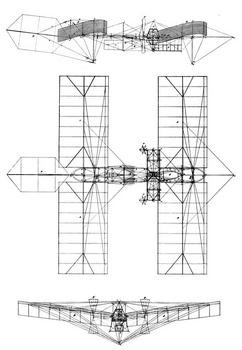
A 3-View of the 1903 Langley Aerodrome from the Langley Memoir of
Mechanical Flight.
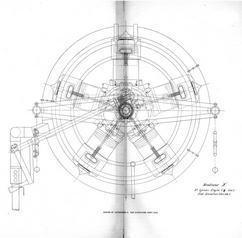
A side view of the Many-Balzer Engine from the Langley Memoir of
Mechanical Flight.
|
|
|
|